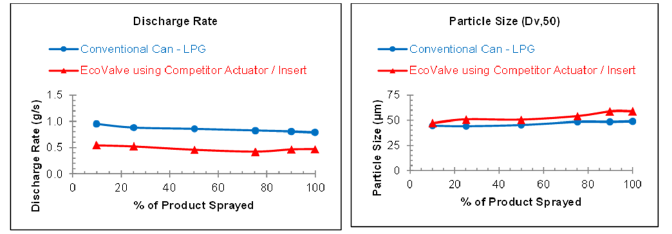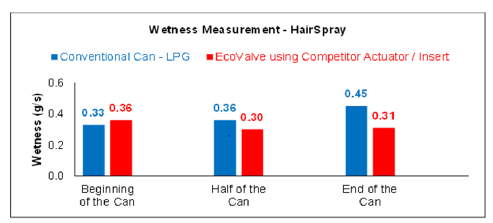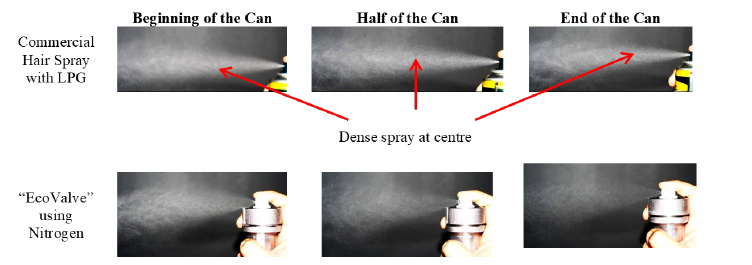- Submissions

Full Text
Academic Journal of Engineering Studies
Novel Two-Fluid Atomisation Ecovalve for Hairspray Products
GG Nasr*
Chair in Mechanical Engineering and Innovation, University of Salford, England
*Corresponding author:GG Nasr, Chair in Mechanical Engineering and Innovation, School of Science, Engineering & Environment (SEE), Spray Research Group (SRG), Petroleum and Gas Labs University of Salford, Manchester, England
Submission: July 11, 2023; Published: August 30, 2023
.jpg)
ISSN:2694-4421 Volume3 Issue2
Abstract
Almost all the domestic aerosol products use hydrocarbon propellants (i.e., butane and propane) in which a high flash vaporisation provides a good atomisation. However, according to the 2015 United Nations Climate Change Conference agreed in Paris and COP 26, Glasgow, UK, these propellants have the adverse climatic effects due to the level of VOC’s (Volatile Organic Compound) which can lead to greenhouse gases. The agreement has given an im-petus to industry to significantly reduce these harmful gases by 2030. Therefore, an alternative energy is required to replace the corresponding hydrocarbon compositions by utilising safer propellant such as compressed gas (i.e., Nitrogen or air). Although the energy of the compressed gas is about 700 times lower than the hydrocarbon propellants, thus spray pattern is not constant through life of the can and as the product is evacuating, the particle size will increase rapidly, and discharge rate will drop sharply. This causes a huge drop out and wetness which is not acceptable for consumers. This article describes the new valving arrangement, called here ‘EcoValve’ that utilises inert gases propellants and ‘bubbly flow’ concept. The valve designed on the bases of two-fluid atomisation and uses all liquid hairspray products that have either solvent or non-solvent compositions. The major challenge of this change is to be able to provide equivalent exothermic energy as in LPG (Liquified Petroleum Gas) via the inert gases to assist good atomisation through the valving system. Furthermore, LPG propellant causes flash vaporisation, thus providing consistent discharge rate and droplet size with adequate wetness and spray dropout through the pack life., The so-called EcoValve and the matching actuators that presented in this artical uses inert gas propellant such as Nitrogen with and without solvent products of different leading brands. Constant discharge rates through life of the can, ranging from 0.4g/s up to 1g/s were obtained with particle size of 40μm and 60μm, depending on the application. Moreover, the wetness and dropout of the corresponding sprays were characterised and also highlighted. In addition, all results, where appropriate, compared with conventional domestic aerosol valve_product using LPG. The new ‘EcoValve’ for domestic aerosol products has fully been piloted and being commercialized.
Keywords:Aerosol; Domestic; Two fluid; Particle size; Discharge rate; VOC; Compressed gas; Atomisation; Hair spray; Solvent
Introduction
The new valving arrangement presented here [1,2], has enhanced these issues by taking advantage of effervescent (or bubbly flow). Bubbly flow is a two-phase flow process in which a small amount of gas (or propellant) is injecting into the product passage before the exit orifice to create bubbles and increase turbulence, thus have better spray break up and very fine spray [3]. There are a number of research about the application of effervescent in domestic aerosols [4]. However, even using a very low value of Gas/Liquid mass Ratio (GLR) causes huge pressure to drop through life of the can, therefore this technique has not been used in commercial aerosols. Also dispensing a mixture of gas and liquid together is very complex. In addition, researchers have been studied on bubbly flow atomizing prediction for modelling drop sizes on high viscous products and also there are some researches about using inert gases to design atomizer inserts for consumer aerosol products [5-9]. The domestic aerosol EcoValve presented in here was initially filed with a number of interlocking patents [8,9] and it has been fully commercialised.
New valving arrangement
There are different types of consumer aerosol products in which most of them are continuous flow valves in which the product with very low viscosity will flow continuously as soon as the actuator is pressed down, and it will stop when the actuator is released. The EcoValve design shown in Figure 1 contains 5 components such as stem, top housing, bottom housing, spring and an inner gasket.
Figure 1:Schematic design of the “EcoValve” [1].

As is shown, the housing is always filled with the product coming through the dip tube which is attached to the tail of bottom housing. When stem is travelling down, the liquid hole should pass the annular sealing ridge and it is revealed to the product and the gas hole must be remain above the ridge to let the air pass through the gas hole. It is also noted that the annular sealing ridge does not need to be perfect tight seal with the outer diameter of the stem due to have an equal pressure of the liquid below the ridge and the gas above ridge. The air and liquid will then mix together in stem mixing chamber and produce a high turbulence flow prior to the insert. The flow will then reach the insert swirl arms subsequent to the insert exit orifice in which the flow breaks to the spray and thus having better atomisation.
Result and Discussion
Ideally the “EcoValve” design should have a similar spray performance to the current conventional aerosols utilising liquefied gas propellant and certainly better performance compared to those conventional inert gas’s aerosol products. The spray performance includes the spray characterisation in terms of discharge flow rate, particle size, pressure drop and spray cone angle. Also, in some domestic aerosol products like air-fresheners and insecticides, the drop out of particles through the pack life of the can is important.
Figure 2 presents the comparison of discharge rate and particle size between a commercial hair spray product with LPG propellant (from an internationally recognised company) and the “EcoValve” design with Nitrogen using a competitor actuatorinsert. Comparing the level of wetness between these two products (see Figure 3), the “EcoValve” produces lower wetness and dries quicker than LPG product when the can is half evacuated. Figure 4 shows the spray images of the commercial hair spray product using LPG propellant compared with “EcoValve” using Nitrogen propellant with competitor’s actuator. As can be seen in the Figure, the spray cone angle is almost constant using “EcoValve” with spray being homogenous and symmetrical through the pack life. Whereas the level of wetness is lower than conventional product in which the spray becomes denser at the centre.
Figure 2:Discharge rate and particle size comparison between commercial hair spray product with LPG and “EcoValve” design using Nitrogen propellant.

Figure 3:Comparison of wetness between commercial hair spray product with LPG and “EcoValve” design using Nitrogen propellant.

Figure 4:Spray images of the commercial hair spray with LPG and “EcoValve” design using Nitrogen propellant.

Figure 5 shows the comparison of spray characterisation (discharge rate and particle size), using the commercial solventbased hair spray with LPG propellant from a European aerosol filler, with the “EcoValve” with Nitrogen propellant. The actuatorinsert purposely designed for the EcoValve.
Figure 5:Discharge rate and particle size comparison between commercial hair spray product with LPG (from European aerosol filler) and “EcoValve” design with Nitrogen propellant.

Conclusion
The “EcoValve” has been designed to introduce the
inert gas propellant into the stem to increase the turbulence thus
improve the spray pattern to be more likely to the conventional
products with LPG propellant.
B. The results obtained by using “EcoValve” and Nitrogen
propellant show that the discharge rate of 0.4g/s to 1g/s and
the particle size of 40μm to 60μm are achievable if the valve and
actuator are matched.
References
- https://www.salvalco.com
- Nourian A, Nasr GG, Yule AJ, Goldberg T, Tulloch G (2015) Next generation of consumer aerosol valve design using inert gases. Proceedings of the Institution of Mechanical Engineers, Part C: Journal of Mechanical Engineering Science 229(16): 2953-2976.
- Catlin CA, Swithenbank J (2001) Physical processes influencing effervescent atomizer performance in the slug and annular flow regimes. Atomization and Sprays 11.
- Kuta T, Plesniak MW (2003) Entrainment control for ligament-controlled effervescent atomizer sprays. Atomization and Sprays 13.
- Asumin (2011) Investigation into novel matched valve-actuator atomiser insert design for compressed gas aerosol. PhD Thesis, University of Salford, England.
- Burby ML, Nasr GG, Hawthorne G, Asmuin N (2014) Novel aerosol insert design utilizing inert compressed gas. Atomization and Sprays 24(12): 1035-1063.
- GG Nasr, AJ Yule, Bendig L (2002) Industrial Sprays and Atomisation. Springer Verlag, Berlin, Germany.
- Ghavami NG, Yule AJ, Burby ML (2011) Aerosol spray device. Patent No. WO2011/128607.
- Ghavami NG, Yule AJ, Burby ML (2011) Spray discharge assembly. Patent No. WO2011/061531.
© 2023 GG Nasr. This is an open access article distributed under the terms of the Creative Commons Attribution License , which permits unrestricted use, distribution, and build upon your work non-commercially.
 a Creative Commons Attribution 4.0 International License. Based on a work at www.crimsonpublishers.com.
Best viewed in
a Creative Commons Attribution 4.0 International License. Based on a work at www.crimsonpublishers.com.
Best viewed in 







.jpg)






























 Editorial Board Registrations
Editorial Board Registrations Submit your Article
Submit your Article Refer a Friend
Refer a Friend Advertise With Us
Advertise With Us
.jpg)






.jpg)














.bmp)
.jpg)
.png)
.jpg)










.jpg)






.png)

.png)



.png)






